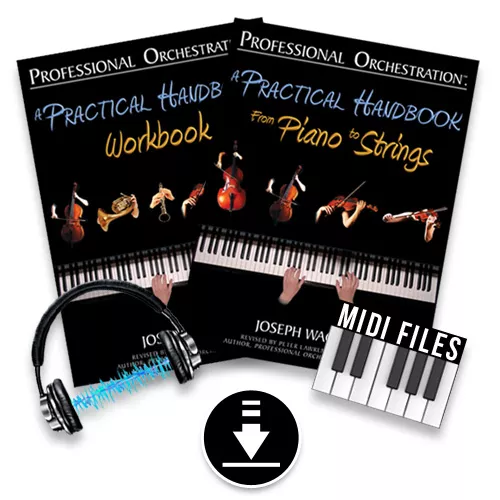Alexander Publishing A Practical Handbook: From Piano to Strings PDF
This Bundle includes the PDF eBooks A Practical Handbook: From Piano To Strings, A Practical Handbook: Workbook and A Practical Handbook: MIDI/Audio Examples Package for a complete self-study solution.
The main Professional Orchestration.™ series of books contains the techniques you need to know to effectively score your music. By comparison, Professional Orchestration’s A Practical Handbook series is applied orchestration where you apply the techniques with real pieces of music, scoring them first for strings, then woodwinds, then full orchestra.
You might find it helpful to go through Professional Orchestration Volumes 1 and 2A alongside the Handbook and Workbook, but they’re not required. You can jump right in with From Piano to Strings, where you’ll learn 13 broad techniques for turning piano parts into full scale string ensembles. The main book is supported by a Workbook, audio and MIDI files in this Bundle.
Background To The Handbook Series
Around 1922, Maurice Ravel finished his astonishing orchestration of Mussorgsky’s Pictures at An Exhibition. Sometime after that, someone talked the publisher of Ravel’s orchestration into adding the piano part at the bottom of the score so students could see how Ravel went from piano to orchestra.
In 1928, Arthur Edward Heacox, building on this simple idea, created the pocket-sized bok Project Lessons in Orchestration which taught orchestration by showing students how to go from piano to orchestra.
About 31 years later, in 1959, came Joseph Wagner, conductor, founder of the Civic Symphony Orchestra of Boston, and teacher of orchestration at Boston University. Dr. Wagner took Project Lessons in Orchestration to the next step by re-organizing Heacox’s material and creating the Reference Chart of Keyboard Idioms which organized piano techniques by comparable orchestral devices.
With this approach, Wagner put the piano part at the bottom of the score with his orchestration above it which, like Ravel’s score, enabled students to see how Wagner, using the same examples throughout the book, went from piano to strings, then piano to woodwinds, and finally, from piano to orchestra.
On the 50th Anniversary of Dr. Wagner’s magnum opus, this new edition of Professional Orchestration: A Practical Handbook – From Piano To Strings, was released as the first of three Handbooks, revised by Peter Lawrence Alexander. Also, the accompanying Workbook, and for the very first time – audio recordings of all the piano examples in the Workbook and the piano examples used in From Piano to Strings, (the same piano examples will be used in the forthcoming Handbooks From Piano to Woodwinds, and From Piano to Orchestra when those Handbooks are released).
About From Piano to Strings
From Piano to Strings is the first Handbook in the series. It teaches you 13 broad techniques from Joseph Wagner’s Reference Chart of Keyboard Idioms for turning piano parts into full scale string ensembles. Each example contains the original piano part and the string ensemble orchestration above it, along with text explaining the background to the orchestration. Newly added text examines MIDI mockup issues. Newly created MIDI examples (included in this Bundle) contain both piano and string parts for you to import into your sequencing software. The piano examples have also been exported from Sibelius and recorded as MP3 audio for you to listen to as you study the Handbook.
Included for additional study is Grieg’s Holberg Suite for Piano and his separate orchestration for string ensemble. See how Grieg used these very techniques to create his remarkable score.
About the Workbook
The Workbook which is used with all three Handbooks in the series, follows the same exact approach. You’re given dozens of piano examples, organized by technique, which you’ll score for the appropriate section, in this case, the String Section. The majority of the piano examples have had their piano parts exported from Sibelius as MP3s (included in this Bundle), so that, regardless of piano skill, you can hear the example and get the sound into your musical imagination. Ideally, you’ll then record your work using either a sequencing program with a quality string library or a notation program that comes with a string library.
Study Approach
First, you study the examples by category in the main From Piano to Strings Handbook, which are organized by specific scoring techniques. Each piano excerpt in the Handbook has been exported from Sibelius and recorded as an MP3 for you. Listen to the piano example, then study. You’re encouraged to record each book example in your sequencing or notation program.
Second, go to the Workbook which has piano excerpts organized by the techniques covered in the Handbook. First, listen to the recorded MP3 example, then score the example by the specific technique taught.
Once you’ve scored your examples (for which there are often a dozen or more possible solutions), you’ll ideally record them using either the orchestra package that comes with your notation program, or by doing a MIDI mockup using your sequencing program. Doing this will help to build your skills in MIDI editing and recording.
Techniques Covered in both From Piano To Strings and the Workbook:
- 1. Broken Intervals
- 2. Broken Chords
- 3. Melodic Lines and Figurations
- 4. Implied Bass Parts
- 5. Single-Note, Interval, Chord Repetitions
- 6. Two- and Three-Part Music
- 7. Spacing Problems in the Middle Register
- 8. Contrast Problems Conditioned by Dynamics
- 9. Voice Leading
- 10. Obbligato or Added Secondary Parts Arranged From Harmonic Progressions
- 11. Antiphonal Effects
- 12. Tremolo Types
- 13. Dance Forms
From Piano to Strings: 146 pgs.
Workbook: 80 pgs.








